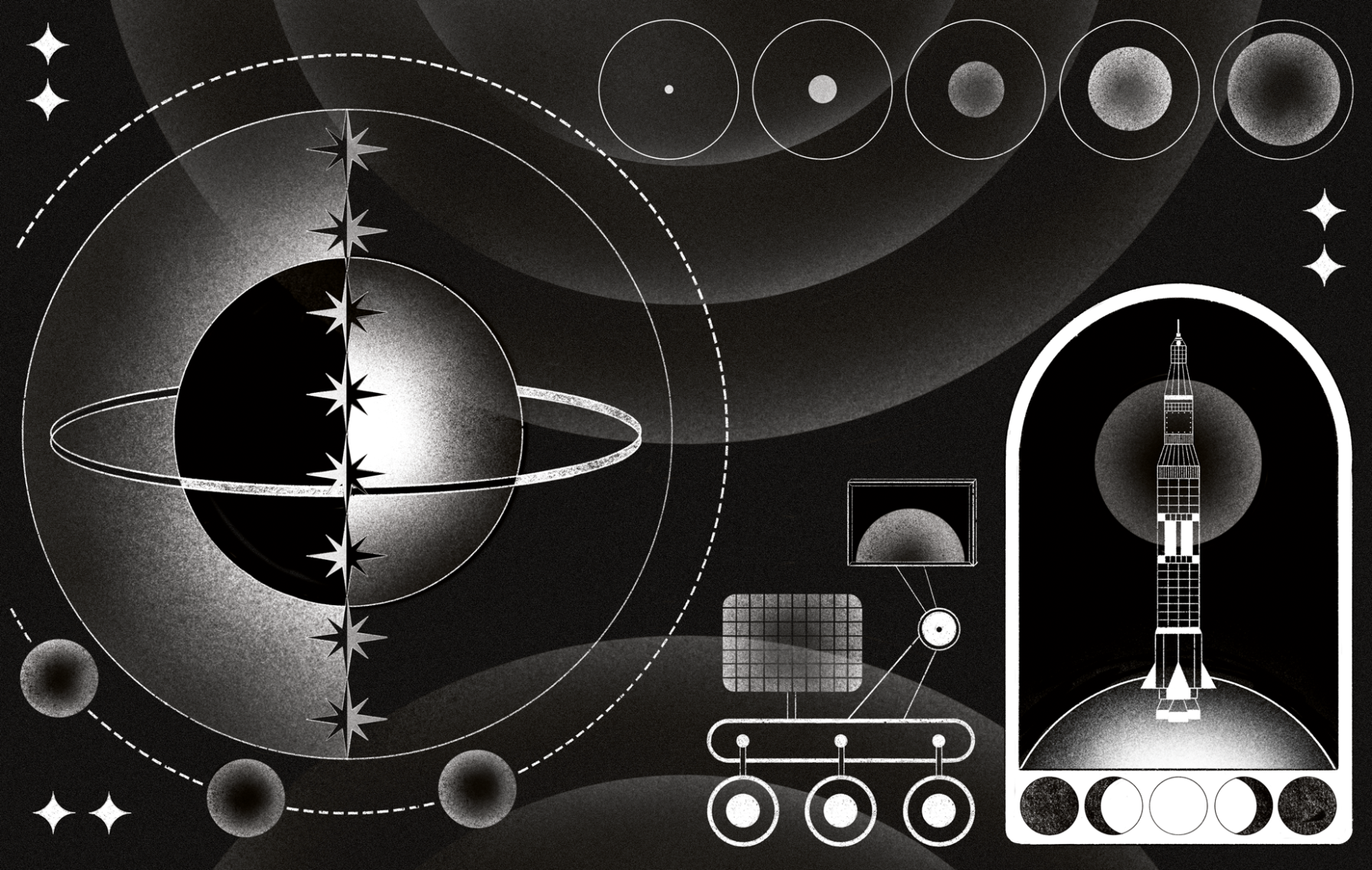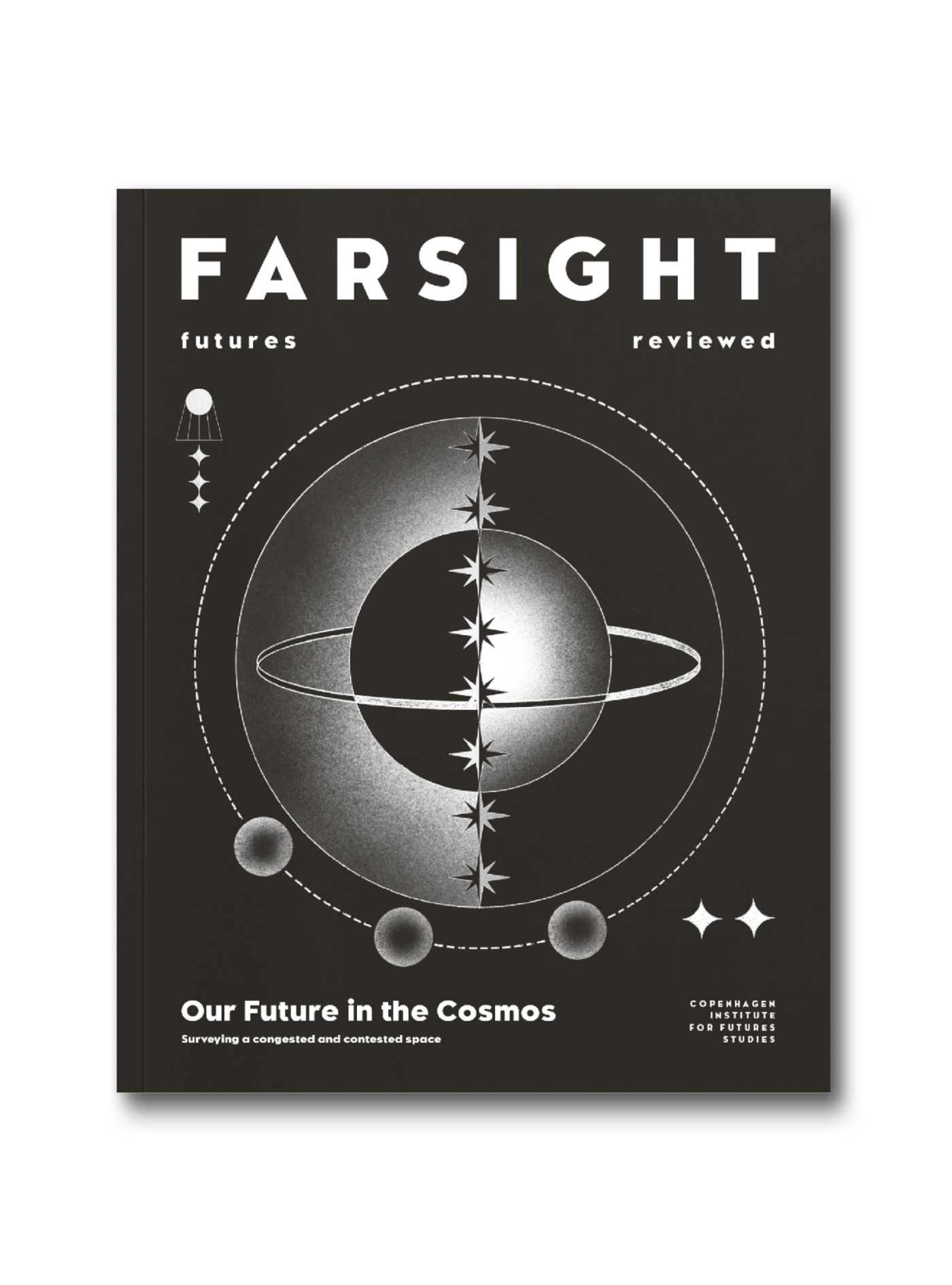
In turn, we use cookies to measure and obtain statistical data about the navigation of the users. You can configure and accept the use of the cookies, and modify your consent options, at any time.

Farewell to the Astronaut?
Why there will always be a need for manned space exploration missions, regardless of technological advances in robotics and AI.
Illustration: Sophia Prieto
Im old enough to remember the Apollo programme, and what an exciting episode that was,” enthuses Martin Rees, the UK’s Astronomer Royal. “That Armstrong took those first steps on the Moon just 12 years after the launch of Sputnik was incredible, and if that rate of advancement had been maintained we would have been to Mars not long after. But there was a super-power rivalry to drive that then and we lack the same motivation now. In fact, the case for sending humans to explore space is only getting weaker all the time.”
Perhaps surprisingly, Rees argues that the future of space exploration is robotic, which is why he has called his new book (co-authored with Donald Goldsmith) The End of the Astronaut. It offers a gloomy prognosis for those who, encouraged by science fiction’s representation of space exploration as involving a lot of people, and not a lot of (less dramatically salient) robots, have hopes of seeing us set foot on other planetary bodies in our lifetimes.

Broaden your horizons with a Futures Membership. Stay updated on key trends and developments through receiving quarterly issues of FARSIGHT, live Futures Seminars with futurists, training, and discounts on our courses.
become a futures memberRees’s case is simple: getting people into space is incredibly expensive, making it a hard sell to taxpayers – and that’s even as the US’ re-born Artemis programme aims to get people back on the Moon by the end of 2025. Indeed, since NASA was established, it has spent about 60% more on human exploration than on robotic exploration, despite having only gotten as far as the Moon with the former, as opposed to the outer rim of the solar system with the latter.
Meanwhile robots are getting cheaper and smarter, as are our abilities to deliver them to ever more remote and tricky destinations – comets and asteroids included. Robots have operated controlled flights and audio recordings on Mars and converted the atmosphere there into oxygen. And yet the space community can seem increasingly divided over whether to lie down and accept that space exploration by machine is inevitable. Indeed, many are vociferous in making the alternative case.
Take Ian Crawford, for one. He’s a professor of planetary science and astrobiology at Birkbeck, University of London and has been pushing for more manned spaceflight for decades. Why? It’s a simple matter of efficiency, he says. A case in point: NASA’s Curiosity rover is faster than previous rovers but still moves some 13 times slower than a crawling human; its Insight lander on Mars spent two years trying to dig a 17-inch-deep hole, what would be a few minutes work for an astronaut.
Every action any probe takes has to be carefully planned. There’s a latency in its operation and, being small, a limit to the tools it can carry. Astronauts, in contrast, can deploy large-scale geologic instruments and, crucially, return far greater sample sizes to Earth. An example could be the still-ongoing studies of Apollo samples that gave us our entire chronology for the solar system, and which recently helped reveal that the Moon is, in fact, about 40 million years older than we once thought. Add a return vehicle to any robot lander and suddenly it’s not so cheap either.
In other words, astronauts are good value for being autonomous. Famously Apollo 15’s commander David Scott spotted an interesting basalt rock on the lunar surface and made an excuse about his seatbelt to stop the Lunar Rover (against Mission Control’s wishes) in order to collect it. No robot is that wily, or so open to serendipity.
People may be more expensive than robots, “but people are also many orders of magnitude more efficient,” says Crawford. “There is simply no comparison in terms of what they can achieve. Look at what the crew of Apollo 17 achieved in three days [of work on the surface of the Moon] relative to what the Mars landers have done in a decade and I don’t think there’s an argument. Humans can think on their feet in ways robots just can’t.”
Crawford concedes that inevitably scientists are a little too fixated on the scientific benefits of space exploration, while governments tend to over-emphasise the benefits to national pride and geopolitical self-confidence. Admittedly, these are the exact forces that allowed a lot of money to be thrown at Apollo – forces that might be heating up again, now that India, China, and the UAE are looking to the stars. But the effort to go further into space can also potentially bring industrial and economic benefits in spin-off innovations and job creation. And, perhaps above all, the thrilling benefit of inspiration: human space exploration has huge socio-cultural value, albeit one hard to quantify.
Arguably that’s why national space agencies put manned spaceflight – or at least talk of it – to the forefront, to keep their budgets healthy. Robots don’t generate the romance that commands the big bucks. It’s also why Crawford is adamant that governments should not, as he puts it, “abdicate their responsibility for spaceflight, not least because government projects are easier to regulate. You don’t want a bunch of space tourists trampling over places before they’re properly explored.”
Yet governments are not so keen on putting humans in space much beyond Low Earth Orbit. And maybe with good reason. Unlike robots, humans not only need rest, food, water, and oxygen, which even the recent innovation of reusable rockets need to lug beyond Earth’s gravity well. They are, as Daniel Britt, professor of astronomy and planetary sciences at the University of Florida, puts it, also “heavy, fragile, dirty [polluting wherever they go], vulnerable and picky about their environment.” Robots are expendable. Astronauts not so much.
And space really is not friendly to life: none are insurmountable problems, but exposure to radiation, micro-gravity and solar flares are all seriously detrimental to good health. Then there are the sheer distances involved: about nine months travel time one-way to Mars – during which an astronaut will have received over 60% of the radiation dose recommended for their entire career – or five years for an orbital trip to Jupiter, where very high radiation levels make a manned mission effectively impossible, at least with current technology. An unmanned scientific payload making a flyby, on the other hand, has no such concerns – just as the European Space Agency’s JUICE spacecraft did earlier this year, with the aim of researching Jupiter’s icy moons.

Explore the world of tomorrow with handpicked articles by signing up to our monthly newsletter.
sign up hereOf course, finding people accepting of the risks is not so much the challenge – “there will still be crazy people who would go even with a 50% risk,” says Rees, “and we should cheer those people on for their readiness to do things at their limits.” The problem is getting the public to accept the risks, which only adds to the cost of manned spaceflight in the systems required to reduce them.
“The public has this delusion that space travel should be safe. But we were, on the whole, lucky with Apollo and lucky with the Shuttle – and people still died. The expectation that astronauts won’t die makes no sense, other than suiting NASA ‘hero’ PR,” argues Britt. “Risk aversion is a recipe for doing very little [actual exploration] because explorers are prone to horrendous levels of death. The problem is that NASA doesn’t want to be associated with failure so a readiness to risk people’s lives is a big step. The incentive [for its managers] without hard deadlines is just to push projects along and retire on an upbeat.”
That’s why Britt contends that the future of manned space exploration is more likely to be driven by private commercial companies the likes of SpaceX, and not by government organisations, especially as, Rees adds, their risk aversion is only going to make human spaceflight more expensive and thus even harder to justify to the public purse. And maybe all the more so when human space exploration today seems rather mundane. “Right now when the toilet on the ISS fails or an astronaut plays guitar in space, that’s just not very glamorous,” Rees says. “It all looks routine.”
That leaves even the likes of Joshua Colwell, professor of physics at the Florida Space Institute, feeling somewhat on the fence. “As a kid I was 100% into the idea of humans going to Mars, but since I’ve learnt how reality is much harder, I’ve been on a bit of a downer on that topic,” he laughs. “We don’t know how it would be like to live on Mars, with 38% gravity, for example, but it doesn’t look great. And I think I’m leaning towards more dramatic unmanned space exploration coming through AI-enhanced robotics.”
“A lot of scientists say you need humans to make decisions in situ. But I’m not sure I buy that today,” he adds. “Yes, humans are faster, but they’re also at least 100 times more expensive. And what’s the rush anyway? Sure, it’s not the same to look at a picture from a probe as it is for someone who can see that sight for themselves. But that’s still a vast number of people not seeing that sight, isn’t it? When you send people deeper into space, they become, in a way, increasingly disconnected from us back on Earth.”
The truth is that the future of space exploration is likely to be a synergistic mix of both the manned and the robotic, not least with the latter as pathfinders for the former. Indeed, that is how, so far, it always has been: Lunar Orbiter, Ranger and Surveyor probes all did crucial analysis of the Moon’s surface ahead of Apollo 11’s landing, much as the Perseverance rover landing in 2021 is doing of Mars now.
But, as Britt stresses, eventually technology will have to offer considerable advances in at least one of two areas. The first will be if robotics provide us with something closer to the insight that humans offer, perhaps even with sensory capabilities greatly exceeding ours (albeit likely pushing up their price too). The second, on the other hand, would consist of robotics providing us with the levels of protection and sustenance required to take humans into space further than Mars.
This synergy of man and machine is a point also expressed by Rees. “I don’t think that interstellar travel will be possible for current humans. It’s other, new types of humans that may spread through the galaxy,” he says. Manned exploration of our solar system beyond the Red Planet – and never mind interstellar exploration – may require a new kind of cyborgian or genetically-enhanced human specially modified for the job. A being suited for what is likely to be a oneway trip to establish outposts far, far away, over a long, long time.
If at all, that is. Rees points out in his book how, in 1997, the cosmo-chemist John Lewis argued that the population growth that off-world settlements promised might provide the key to human flourishing, since what’s crucial to this would
be intelligence and innovation, and we need more people to increase the odds of more geniuses being born. Others, of course, have suggested we need to take those baby steps to settling other planets, given that ours will eventually die, and maybe sooner than planned “if we muck it all up,” as Rees says.
But Colwell has another idea, one even more depressing for those for whom manned space exploration embodies some kind of hope in gloomy times: that space exploration is not just for humankind, but for extraterrestrial kind too. Maybe the Fermi Paradox – that if the galaxy is teeming with life, where is it all? – is explained by the simple notion that interstellar travel isn’t just beyond our capabilities, but beyond those of all lifeforms. “That means we’re isolated,” says Colwell, “even as that notion cuts up against that intangible desire that we humans have to go to the next place.”

This is an article from FARSIGHT:
Our Future in the Cosmos
Grab a copy here